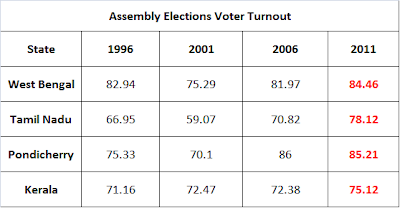
However, there is a strong likelihood that this increase was not merely because of discontent. After all, anti-incumbency factor is common in Indian democracy, and has rarely resulted in such uniform jumps in voter turnouts.
Incidentally, this was the first election where an electoral slip was delivered to all voters following a directive from the Election Commission of India (ECI). Accordingly, less than a week (most often 3-4 days) before the polling day, an electoral slip containing the date of polling, location of polling booth, serial number of the voter in the voters list, and his/her photo was delivered to all voters. Traditionally, voters slips were disbursed by political parties during the campaigning, especially to their potential voters, so as to encourage them to vote.
If the delivery of voters slips contributed to the inceases in voters turnout, then its transmission would have been through two routes.
1. The voters slips, delivered just before the polling day, may have served to remind voters about their voting obligation and generated a form of social pressure on the voter to turn up to vote. In other words, the slips may have primed the voters into voting.
2. The voters slips - especially the location of the polling station, date and time, and the reassurance about their names being on the voters list - may have served as "channel factors" that bridged the information asymmetry and nudged the voters into visiting the polling booth to cast their votes.
Either way, unwittingly, the ECI may have used a powerful insight from behavioural psychology to nudge citizens into voting. This may also be a powerful reminder to advocates of making voting mandatory that such subtle nudges are a more effective and sustainable approach to increase voter turnout.
PS: There is no confirmation that voters slips were responsible for the increase. The increases in turnout from 2006 to 2011, where voter slips were not used, does complicate drawing ready inferences. I am sure that in the coming days atleast some researchers would use constituency data to tease out effects, if any.
1 comment:
Dear Gulzar,
In every election, we see the repeated farce of people being urged to vote - and a lot of talking-up of the election process, and what it means in a democracy ( the most critical...people's voice ...etc.,).
Elections are only an aggregated solution / response in a democracy - median voter theorem and all that - and by far the most imperfect mechanism to address specific issues.
I think we are getting carried away by the rhetoric of democracy / freedom /choice etc.,
Elections signify the last resort ... in the absence of good institutional mechanisms that work with integrity, improving voting percentages by itself means little.
Not to knock the good work, but the rhetoric of "your vote can make a difference" - is hollow in the absence of a substantive engagement on policy issues between the public and politicians - and No, the motor mouths that inhabit the media landscape - don't make things any better.
regards,KP.
Post a Comment